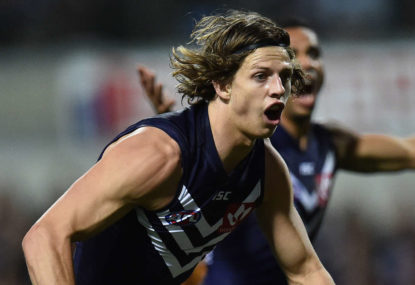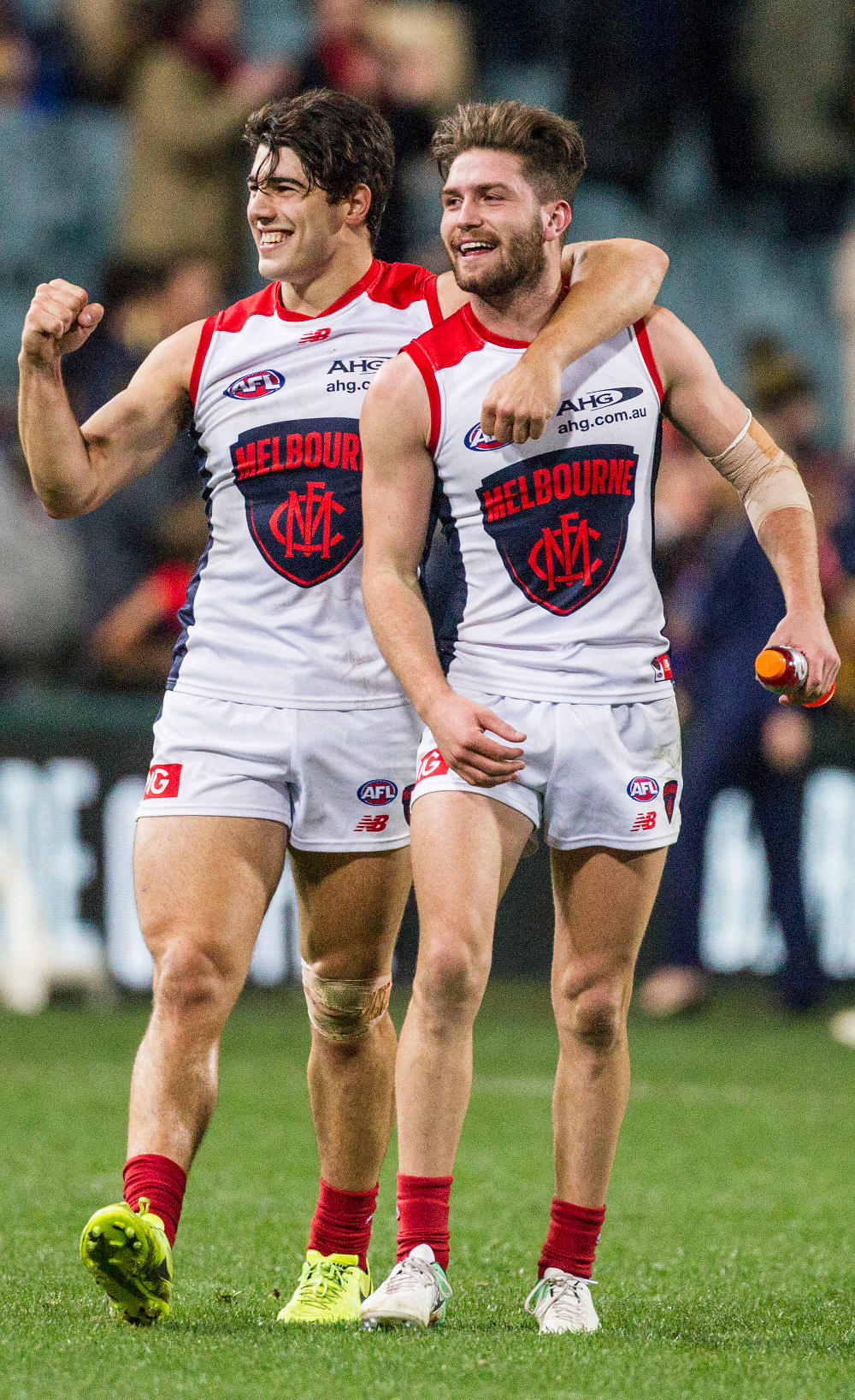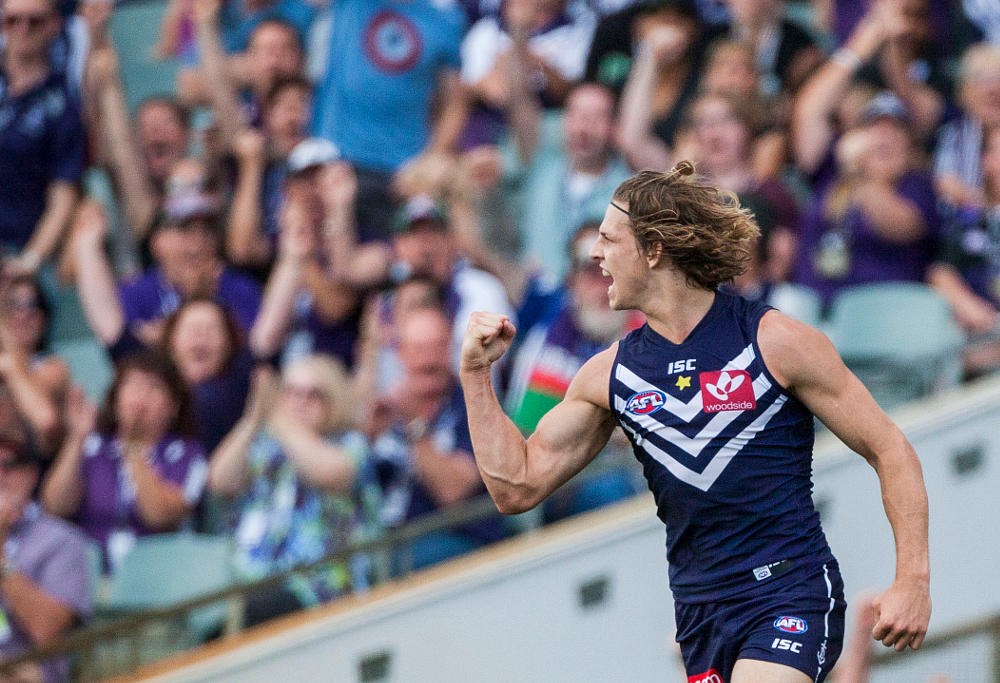LISTEN: 'Presidents don't want 19 teams' - Eddie McGuire's dire warning to North Melbourne
The former Collingwood president says the Kangaroos need to 'stand for something' not just on the field but in the community or risk being…

Selecting this year’s All Australian team is an exercise in box ticking. Instead, let’s see if we can build a better team, from players who were not picked for the squad earlier this week.
» The Roar’s 2017 All Australian team
About a month ago, I put together an All Australian team with a handful of rounds remaining, and tweeted it out – as is the thing to do.
Of the 22 I named, 20 made it into the squad, and will almost certainly be named in the team later today.
Pretty much picked itself #AFL pic.twitter.com/jHiQSHsWeO
— Ryan Buckland (@RyanBuckland7) August 1, 2017
The two that didn’t, Nat Fyfe and Ollie Wines were among the handful of befuddling decisions and non-decisions made by the All Australian selection panel this season.
According to the media release accompanying the announcement of the squad, the selection panel got together and came up with a list of who they collectively thought were the best 40 players in the competition this season. That’s of course why Nat Fyfe didn’t make the team and, say, Port Adelaide’s Tom Jonas did.
Notice I felt compelled to include Jonas’ team in front of his name. There is only a modicum of disrespect intended for Jonas – he had a fine season, easily his best, as he emerged as Port Adelaide’s number one defender.
The Power were one of the league’s stingiest defences, although the role Jonas himself played was likely helped by the Power’s preference for an ultra-high press and smart zoning through the middle of the ground – which meant they conceded the fourth fewest inside 50s in the competition.
Jonas had himself a solid season. Was it even the 40th best season in the competition? Almost certainly not.
Similarly, Collingwood’s Adam Treloar, who wasn’t even the second best midfielder at his club. Jeremy McGovern is an outstanding defender, but when you play 40 per cent of the season as an utterly ineffectual key forward, surely that has to figure into proceedings. Seb Ross gathered plenty of hardballs, but how many couldn’t have been won by Jack Steven, Jack Steele or Jack Billings?
There are bizarre squad inclusions everywhere you look. Ditto exclusions: Fyfe and Wines were in the best 40 players in 2017, as were teammates Lachie Neale and Brad Ebert. Callan Ward, who is now officially the most underrated player in the competition, is the glue that holds the explosive Greater Western Sydney midfield together. Trent Cotchin, Clayton Oliver, Dane Rampe, Jack Macrae, the list goes on.
It got me thinking. Is it possible to build a team made up of All Australian squad snubs that could take it up to, or even beat, the actual squad?
Yes, I believe it is. And here it is.
The Nathan Jones All Stars
The team is named the Nathan Jones All Stars, and will be so long as Nathan Jones is not named an All Australian. We are looking beyond the flash and gaud of the biggest names of the competition, and for football output above all else.
Jones epitomises this. His 239-game career has mostly played out in the depths of Melbourne’s despair, captaining the team for a hefty chunk too. Jones’ 16-game 2017 season yielded nine wins, in what was his first winning year in 12 attempts.
Prior to his absence this season, Jones had missed five games in his 11 years from debut, and had played 109 consecutive games between Round 15 2012 and Round 13 2017. He’s not in it for the headlines, he is in it to play high-quality football, and that’s what he does.

AAP Image/Julian Smith
There are two rules for eligibility for the Nathan Jones All Stars: you must have missed selection in the All Australian squad, and you must have played at least two-thirds of the season (15 games). That’s a slightly lower benchmark than the measuring stick for All Australian team selection (history says 17 games is generally the cut-off). If a player happens to be a personal favourite, or has a signature move or mode of play, that’s helpful.
Our goal is a bit more nefarious than the All Australian team selection process, but overtly so. We will build a starting 18 made up of the best possible players who are available for selection and who fit together with the style of play I’m looking for. We fill out the rest of a hypothetical squad of 22 thereafter. Then we will select a bench of four who best complement the starting 18.
It’s a reverse of the All Australian team process, but in a way that means it is exactly the same as the All Australian team process.
Finally, there are three types of Nathan Jones All Star: the superstar snubs, the injured injustices, and the hidden gems. There are sub-types but look I’m guessing you really want to see this team.
The 2017 Nathan Jones All Stars
| FB | Z Williams | D Rampe | D Astbury |
| HB | S Hurn | P Davis | Z Tuohy |
| C | M Duncan | C Ward | T Cotchin |
| HF | M Walters | J Riewoldt | C Petracca |
| FF | J Billings | J Patton | C Wingard |
| Fol. | S Martin | N Fyfe | O Wines |
Let’s go line by line and make the case for each selection.
The back six
The back six was a challenge, because the selection panel largely got this area of the ground 100 per cent correct.
The starting talls should be Alex Rance and Michael Hurley, the flankers should be Sam Docherty and Michael Hibberd, and the flex spots should be Neville Jetta and Rory Laird. The panel hoovered up plenty of other potential names, as they should have. Jeremy Howe and Jake Lever are unlucky to miss out, and could be candidates for a bench spot later this evening if the panel is that way inclined.
So, we were left with what is mostly a genuine second team line up.
Dane Rampe and Phil Davis anchor my defence, as two of the best one on one stoppers in the competition. Rampe was presumably left out of the All Australian squad on account of his games played, given he was arguably the leader of what emerged as unarguably the best defence in the competition.
Richmond’s David Astbury is my flex defender; as Rance’s protégé, Astbury often took the full back spot to allow Rance the room to roam the wider parts of the Tigers’ back 50. Having these three tall defenders should see my team match up well against what looms as a tall All Australian forward line (six talls were selected in the squad).
Outside of this group, I want the rest of my defence to have a bias for attack – and for long kicking. The best teams of this season played at least two of their defenders much higher up the ground, starting them at the back of the centre square or on a wing and starting the wingers at the back of the centre square. Michael Hibberd and Rory Laird are the avatars for this but are unavailable.
In their stead, we select Geelong’s Zach Touhy, GWS’s Zac Williams, and West Coast’s Shannon Hurn. All three played career years, with Touhy a genuine All Australian squad snub. Williams is a ground-ball get machine, has one of the quickest triggers in the league, and has demonstrated an around-the-ground flexibility this season.
Williams and Hurn would take the primary small forwards by way of match ups, with Touhy available to act as a spare defender or roam further up the ground as a score set up threat. My trio of rebounders can be a little untidy with their disposal, but that fits the structure of my forward line nicely.
[latest_videos_strip category=”afl” name=”AFL”]
The front six
Small and flexible is en vogue. It is really hard to get away with a three tall forward line up as a base look in 2017; some teams, like the Giants and Swans, get away with it as an alternative to a two-tall line up. St Kilda found that out the hard way this season.
The Adelaide Crows are unique in this respect, given they play four tall players in their forward half, albeit Tom Lynch is more a winger who timeshares forward than a genuine tall forward.
Much of the rest of the league followed the lead of the Western Bulldogs in rolling out flexible front six line ups, populated with medium-sized aerial threats and a raft of smaller ground ball threats. Richmond threw convention out of the window altogether, playing Jack Riewoldt as the singular tall threat and surrounding him with three or four small forwards at all times. Dustin Martin also spent plenty of time as the deep threat with Riewoldt as a more traditional centre half forward with that look.
This is the way we will go. Robbie Gray and Dane Zorko, the two most likely candidates for this kind of role, are sure to be selected in the All Australian side and so are unavailable. Instead, we turn to Michael Walters, Christian Petracca and Chad Wingard, all of whom played career-best years and, in the case of the former and latter, would have been borderline All Australian squad selections with full years under their belts.
Both Walters and Wingard missed parts of the season on account of injuries; Walters’ year wrapping up in Round 18 on account of a PCL injury and Wingard dropping out twice with multi-week niggles. The duo played more time in the midfield than their careers to date, averaging 20 disposals and more than a goal a game each.
Petracca gets in because I am the selector, but also because he emerged as one of the most damaging offensive players in the competition. Similar to Walters and Wingard, Petracca doesn’t get the gaudy possession tallies of others, but was just shy of 20 touches a game and averaged almost 11 contested possessions. The great thing about Petracca though is he averages a 60-40 forward half split, and can spend time starting in the centre square. He affords the flexibility we’re chasing.

AAP Image/Tony McDonough
Jack Billings is my notional small forward, although he plays much higher than the archetype in his role for the Saints. Billings has a strong nose for goal, evidenced by his seven games with at least four scoring shots. It was tempting to insert either Dan Butler or Orazio Fantasia in this slot, but Billings offered more by way of flex further up the ground.
I went with two tall forwards. Riewoldt finished fifth for goals kicked, despite missing two games, and was just outside of the top 20 in score involvements. He played as the lone tall forward in most games, meaning he won the spot over other worthy tall forward candidates. For the second spot I was tempted to pick GWS’s Jeremy Cameron, but I went with teammate Jonathon Patton, who was fourth in the league for contested marks among full-time forwards, and would play in my set up with a chain on his ankle that doesn’t allow him to move beyond the 50-metre arc.
The midfield
My midfield group is made up of snubs: Mitch Duncan, Callan Ward and Trent Cotchin on the centre line, and Nat Fyfe and Ollie Wines in the follower spots.
The centreline appears to have been overlooked because of the higher profile nature of their teammates. Duncan played a career year, providing the glue for Geelong’s midfield and working both wings with ground ball gets and uncontested marks. Many Geelong fans thought he should have been picked in the All Australian squad over Joel Selwood – I agree.
Ward suffers a similar fate to Jones; he’s unassuming, does a lot of his work on the inside, and simply goes about his business consistently and with ruthless effect.
Cotchin had a stellar year freed of some of the inside workload, on account of the insertion of Dion Prestia into the Richmond line up, free wheeling across the ground and setting up the Tigers’ attacks from the half back line.
Fyfe was snubbed because he wasn’t 2015 Nat Fyfe. After a relatively slow start in the first third of the season – in which he averaged 27 disposals, 6.3 clearances and 15.1 contested possessions – Fyfe warmed up heading into the second half of the season, at which point he went nuclear. Between Round 15 and the end of the season, Fyfe averaged 2.9 contested marks, 16.4 contested possessions and seven clearances per game. His influence on Fremantle grew over time, and there is little doubt by the end of the season that he was back to a level near his all-time peak.
Fyfe might have been a top-50 player in the first half of the season; he was one of the best handful in the second half of the season. Yet he isn’t one of the best 40 players in the competition for the year as a whole? It makes you wonder how much football some media members take in.

AAP Image/Tony McDonough
Wines is a bit of a niche case of mine. He reached a career high for disposals, averaged five tackles, four inside 50s, six clearances, 14 contested possessions and just under seven score involvements per game, despite not really hitting the scoreboard himself. Wines tidied up his disposal this year too.
Brisbane’s Stefan Martin, the best available ruckman outside of the three correctly picked in the All Australian squad, is my ruckman. Martin does all the heavy lifting up north, but in keeping with my flexibility mantra isn’t just a hitout machine: he averaged four marks, 17 disposals, five clearances and almost three tackles per game. Hawthorn’s Ben McEvoy had a similar profile, but I prefer Martin’s volume of around-the-ground work.
The Nathan Jones All Stars midfield doesn’t have the star power of the likely All Australian team of Josh Kelly, Josh Kennedy, Zach Merrett, Paddy Ryder, Patrick Dangerfield and Dustin Martin. But it would push it for on-field performance, and that’s what we’re concerned with here.
The bench, and rest of the squad
Finally, the final four spots and the rest of the squad for 2017. As above, we’re trying to pick the best available 22 players who didn’t make the starting 18, and we’ll work out a bench from there. Here’s the squad.
| Int. | J Macrae | C Oliver | N Jones |
| T McDonald | |||
| Squad | D Beams | Z Jones | C Pederson |
| S Burgoyne | J Lyons | S Pendlebury | |
| J Cameron | A McDonald- | N Smith | |
| B Ebert | Tipungwuti | D Talia | |
| B Goddard | B McEvoy | T Rockliff | |
| T Hawkins | M Murphy | N Wilson | |
| L Neale |
Each member has been picked for their contribution to their team’s success over the year, and their standing in the game in this season and this season alone. There are a handful of players in here that should be in contention for the All Australian squad, and perhaps a borderline team case or two sprinkled in for good measure.
In terms of the bench, I couldn’t go past Jack Macrae, Nathan Jones himself and Clayton Oliver as the spare midfielders. Each offers their own unique attributes, mostly ball control and quality disposal in the case of Macrae and Jones, and ball-winning in the case of Oliver.
For the final spot, I went with the best swingman in the league in 2017, Tom McDonald. McDonald is an outstanding key defender who the advanced metrics used by Champion Data and many clubs across the league love to bits; he also took 23 shots (for 18 goals) and generated six direct assists in an eight-week stretch as Melbourne’s number one key forward. He can play in the ruck, too.
One of the most frequent, and mostly ignorant, comments regarding the selection of the All Australian team every year is that it’s a pointless exercise because the team doesn’t play anyone. Well, they could play the Nathan Jones All Stars. They might even lose.